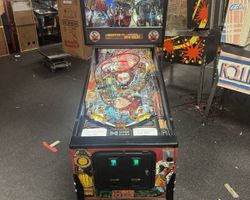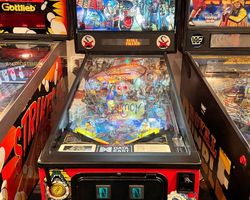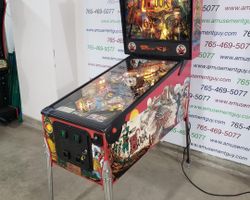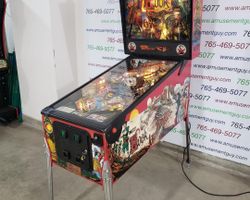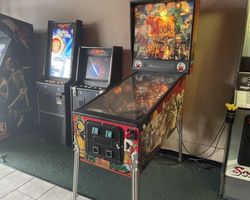Hook
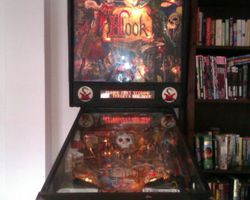
Average Prices: USD $600 to $1,900
Produced: January, 1992
Production Run: 6,705 units
Machine Type: Solid State Electronic
MPU: DataEast/Sega Version 3
Players: 4
Design by: Tim Seckel
Art by: Paul Faris
Music by: Brian Schmidt
Sound by: Brian Schmidt
Software by: Neil Falconer
The Data East pinball machine Hook, released in January 1992, plunges players into the vibrant, swashbuckling world inspired by the popular film. Manufactured by Data East USA, Inc., this solid-state electronic (SS) pinball title captured the adventurous spirit of the movie, aiming to bring Neverland's magic to arcades and home collections.
History and Background
Data East, a prominent pinball manufacturer in the early 1990s, built a reputation for its diverse array of licensed themes, often drawing from contemporary films and pop culture. Hook emerged from this strategy, leveraging the appeal of the fantasy-adventure movie. The machine's development was spearheaded by designer Tim Seckel, with the distinct visual style crafted by artist Paul Faris. The immersive soundscape, featuring music and effects, was composed by Brian Schmidt, who also handled the sound design. Neil Falconer was responsible for the game's software.
Interestingly, Hook did not begin as a direct adaptation of the movie. Initial concepts for the pinball machine were rooted in a broader "Universal Studios Theme Park" idea, existing only in a drawing and ideation phase. When the opportunity arose to license the Hook film, the pinball project swiftly pivoted, adopting the movie's theme and accelerating its development. This rapid transition speaks to Data East’s agility in securing and implementing popular licenses.
Released on January 30, 1992, Hook saw a production run of 6,705 units, a solid output for the era. During its production from late January to early June 1992, some subtle design variations emerged. For instance, the prominent circular Windcoaster ramp, a central feature of the playfield, originally featured a detailed "6-layer tree" plastic. This elaborate tree, while aesthetically rich, was later modified to a "2-layer tree" in many production units. This change aimed to reduce shadowing on the playfield and improve visibility of the action around the pop bumpers and top lanes, a practical adjustment based on testing and early player feedback. A small, unadorned metal bracket also exists on the playfield, strategically placed to prevent balls from becoming wedged in specific areas near the wire ramps, illustrating the iterative nature of pinball machine design to address potential gameplay issues.
A rare prototype version of Hook also existed, featuring a unique polarizing spinning disk behind the backglass. This disk was designed to create a visual effect for a handmade Tinker Bell hologram affixed to the backglass, enhancing the ethereal presence of the character. While this captivating feature made it into a limited number of early production or export units, it was not present in the majority of the production run. A notable piece of trivia surrounding the machine is that a personalized Hook pinball machine, given to actor Robin Williams by Steven Spielberg, later sold for a significant sum following Williams's passing, highlighting the personal connection many had with the film and its adaptations.
Signature Features and Design
Hook sets itself apart with several prominent design elements that directly tie into its movie theme. At the heart of the playfield lies a striking skull sculpt, a direct visual cue to Captain Hook's pirate motif. This central feature often serves as a focal point for various shots and objectives.
The most visually dominant mechanical feature is the large, transparent circular Windcoaster ramp. This distinct ramp, representing the whimsical modes of transport in Neverland, offers a unique shot trajectory. Its design includes an overhead plastic structure that originally featured a multi-layered tree, contributing to the playfield's layered aesthetic. The ramp itself is illuminated, with lights integrated into its structure, making it a prominent visual and gameplay element.
Beyond the major ramp, Hook incorporates a set of four drop targets, arranged in a bank, which are crucial for advancing gameplay and initiating multiball sequences. A vertical up-kicker (VUK) and a scoop target provide additional shot variety, often leading to specific modes or awards. The game also includes three pop bumpers located in the upper playfield, providing classic pinball action and high-energy ball movement.
Paul Faris's artwork on the playfield and cabinet is characterized by its vibrant colors and dynamic portrayal of characters and scenes from the movie. While some found the artwork "busy," its detailed nature and direct correlation to the source material contributed significantly to the machine's thematic immersion. The mirrored backglass features lit inserts for the top lanes, a thoughtful design choice to compensate for the difficulty of seeing the physical lights on the upper playfield.
Playfield and Mechanics
The playfield layout of Hook is designed for a combination of open flow and targeted precision shots. The lower playfield features two flippers providing control, flanked by two slingshots that react energetically to ball contact. Directly above the flippers are the entrances to the two main ramps: the aforementioned circular Windcoaster ramp on the left, and a more conventional wire ramp on the right. Both ramps offer rewarding shots for points and mode progression.
The upper playfield is home to three pop bumpers, creating a chaotic yet satisfying area where the ball can careen for multiple hits. Leading into this area are several top lanes. Just below the pop bumpers is the four-bank of drop targets. Successfully clearing these targets is a key objective, often linked to activating multiball. Surrounding these core elements are ten standup targets, providing numerous opportunities for quick points and triggering minor awards.
A vertical up-kicker (VUK) is strategically placed to eject the ball from the playfield into the upper areas or onto a wireform return, adding a dynamic element to ball movement. A single scoop target, often representing a hidden treasure or objective, collects the ball for specific mode initiations or awards. The overall flow encourages players to cycle between shooting ramps, clearing drop targets, and hitting standups to advance through the game’s various objectives. The playfield artwork ties these elements together, with detailed character renditions and environmental scenes from Neverland, creating a cohesive visual narrative. The lighting, while functional, complements the artwork, highlighting key shots and indicating active modes.
Gameplay Dynamics
The gameplay experience on Hook centers around activating various modes and achieving multiball. The scoring system encourages players to hit specific targets and ramps to build up their score and progress through the game's narrative. Players are presented with several distinct modes and objectives, which, while straightforward, offer clear goals. These modes are typically initiated by hitting specific targets or collecting certain sequences. For instance, the four-bank drop targets are instrumental in triggering the multi-ball feature, a high-scoring opportunity where two or three balls are in play simultaneously, maximizing scoring potential.
A unique aspect of Hook is its skill shots. The plunge skill shot, which involves carefully launching the ball to hit specific targets or lanes at the start of a ball, provides an immediate challenge and a rewarding bonus for precise execution. This element adds a layer of skill, distinguishing a controlled start from a simple plunge.
While the game offers multiple modes, the progression is generally considered accessible, making it an inviting machine for newer players. Objectives are clearly communicated through the Dot Matrix Display (DMD) and callouts. The game’s sound package, featuring quotes and effects directly from the movie, contributes significantly to player immersion, guiding them through the unfolding adventure. Players aim to cycle through the various modes, collect "treasure chest" awards, and repeatedly initiate multiball to achieve high scores. The large circular Windcoaster ramp, while visually impressive, can be a challenging shot for some players, demanding accuracy and a strong flipper.
Reception and Legacy
The Hook pinball machine has garnered a mixed but generally favorable reception within the pinball community. Its strengths are frequently highlighted, particularly its strong thematic integration. Fans of the Hook movie appreciate the vibrant artwork by Paul Faris, which brings the film's characters and scenes to life on the playfield. The sound package, with its movie quotes and music by Brian Schmidt, also receives praise for enhancing the theme and creating an immersive experience. Many consider Hook to be an enjoyable and engaging game, especially for casual players and families, due to its accessible ruleset and clear objectives. The game's value proposition is often mentioned, as it can be acquired at a reasonable price point relative to its entertainment value. The plunge skill shots are noted as a rewarding aspect, encouraging players to master their launch technique.
However, Hook is not without its criticisms. Some experienced pinball enthusiasts find the ruleset to be relatively shallow, lacking the depth and complex scoring strategies that might appeal to more seasoned players. The game's callouts and shots, while thematic, can become repetitive over extended play sessions. Visually, some reviewers found the artwork to be "busy," and a few noted that the likenesses of some characters, such as Robin Williams, were not perfectly rendered. Gameplay speed is another point of contention, with some players finding the action to be slower than other titles of the era. Certain shots, like the Windcoaster ramp, can be difficult to consistently hit, leading to frustration for some. Reports of potential build quality concerns and the scarcity of certain replacement parts have also surfaced. The scoring balance has been identified as an area that could be improved, leading to less strategic play for high scores.
Despite these varied opinions, Hook holds a distinctive place in pinball history as a Data East title from the early 1990s, representing their Version 3 MPU generation. Its legacy lies in its role as a machine that often serves as an accessible entry point for new players and families into the hobby. While it may not command the same high prices as some of its contemporaries, its enduring thematic appeal and generally straightforward gameplay ensure its continued presence in collections and public locations, a testament to its enduring charm.
Sponsored Links
 Ebay Listings
Ebay Listings
 Auction Results
Auction Results
| Cost | Location | Date |
|---|---|---|
| USD $4,000 |  Florida, United States Florida, United States |
26 November, 2025 |
| USD $4,000 |  Florida, United States Florida, United States |
28 October, 2025 |
| USD $3,575 |  Indiana, United States Indiana, United States |
27 March, 2025 |
| USD $3,575 |  Indiana, United States Indiana, United States |
10 March, 2025 |
| EUR €2,594 |  Nordrhein-Westfalen, Germany Nordrhein-Westfalen, Germany |
10 December, 2024 |
| USD $3,500 |  Virginia, United States Virginia, United States |
25 June, 2024 |
| USD $2,500 |  Maryland, United States Maryland, United States |
06 June, 2024 |
| GBP £3,950 |  United Kingdom United Kingdom |
20 May, 2024 |
| USD $700 |  Florida, United States Florida, United States |
30 January, 2024 |
| USD $4,375 |  Indiana, United States Indiana, United States |
27 November, 2023 |


Private Policy · Search Website · Contact Us
As an eBay Partner, we may earn a commission from qualifying purchases made through links on this site, at no additional cost to you.
All trademarks and copyrighted materials remain property of their respective owners. All other content copyright 2007 - 2025 Pinpedia.


